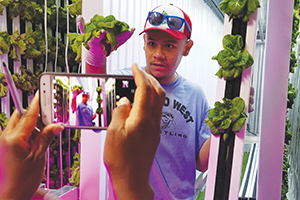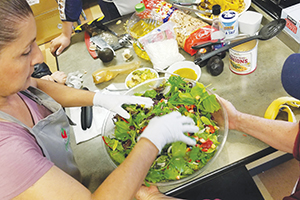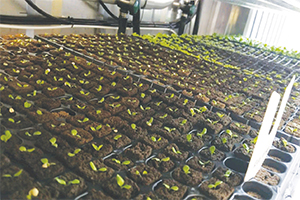By DALE SINGER
A lot more than lettuce seedlings are sprouting in a con-verted railroad shipping container sitting in prime parking spaces outside Saint Joseph Hospital in Denver.
Sure, the hydroponically grown crops are the physical product of the project operated by the hospital and by Metro Caring, an anti-hunger organization. But the results that you can't see or taste — a thriving partnership, a move toward economic stability and healthy nutrition, a sense that people can take more control over their own destiny — can last longer than any veggies will.

Ault
Chuck Ault, the hospital's regional director for community health improvement, says that the very visible shipping container — known as the Leafy Green Machine, emblazoned with the slogan "Planting Seeds to End Hunger" — is a strong representation of more subtle efforts that could easily go unnoticed.
"So much of our work together isn't tangible," he says. "You can't point to it and say, 'There it is.' But the freight farm is so big and so obvious and so tangible, people can wrap their heads around it."

A hydroponic farm prominently positioned outside the main entrance to Saint Joseph Hospital in Denver signals patients and community members that health and nutrition are connected. Metro Caring, an anti-hunger community organization, operates the farm, which is housed in a converted railroad shipping container. The vertical towers shown here rely on gravity to optimize the use of water in irrigation.
Adds Jess Harper, gardener and community activator at Metro Caring: "It really is a showcase of the partnership of what we have, our shared values. And customers get the best local greens they could possibly have found, growing quite literally across the street" from Metro Caring's food pantry. "That's super, super cool."
Fully contained
The freight farm, also known as a shipping container garden, measures 40 feet long and 8 feet wide. It uses technology to monitor and control the climate and watering. The process, which conserves water and yields high-nutrient crops, works like this:
After being sown into a spongy plug of peat moss and other organic matter, seeds are sprayed with nutrients and water, and nested under lights that produce an artificial day/night cycle. When the sprouts grow to about 1 to 2 inches, they are stacked — spongy plug and all to protect the root structure — into thin vertical towers. Nutrient-enhanced water trickles down parsimoniously from plant to plant. LED full-spectrum lights stimulate photosynthesis.
It takes an average of seven weeks, depending on the variety, from seed to harvest. Sometimes crops can take as little as five and a half weeks to be table ready. "When fully operational we can harvest a crop of 600 plants every week, all year round," Harper says.
Just as light and water make plants thrive, the freight farm project is nurtured by a partnership dedicated to improving health and nutrition in the hospital's neighborhood.
About two years ago, Metro Caring had the chance to obtain the hydroponic farm/container car, thanks to a grant from the
Morgridge Family Foundation. The foundation already had put two hydroponic farm trucks in Denver area schools, to teach students about where food comes from. Metro Caring wanted to reach another segment of the community with its advocacy for access to good nutrition and its anti-hunger, sustainable agriculture message. It found a home at Saint Joseph.
Food as medicine
"I said, 'Absolutely, we can find a place on our campus for that,'" Ault recalls. "Then I saw it and said, 'holy moly, that's the back of a semitruck!'"

Jess Harper, gardener and community activator at Metro Caring, shows LED strip lights used to stimulate plant photosynthesis.
The hospital needed to find a spot with a level grade and a nearby power and water source. It carved out a half dozen parking spaces, right in front of the main entrance for the container car.
"That seemed to be a location that everyone in the hospital thought was extremely suitable," Ault says.
"What attracted us is that we as a hospital had embraced the notion that food insecurity was a driver for poor health. If we had nutritious food growing outside the main door of the hospital, we could show that health and nutrition are connected. That's not necessarily something everyone who walks into the front door is thinking about."
Good value
The freight farm was delivered in 2018, at a cost of about $80,000. "For the refrigerated container, outfitted with a hydroponic system and specialized technology to climate control for year-round growing of greens, this is actually an extremely reasonable price," Harper says. "When you compare it to the land purchase, farm loan, equipment purchase, labor costs, and — perhaps most importantly — the cost of water in Colorado, this turns out to be a very competitive up-front cost.

Produce from the freight farm is given to clients at Metro Caring's nearby food pantry facility and used by cooking club members who meet there.
"Additionally, because this system can be operated year-round, versus the natural growing season, farmers using these systems are able to make up the capital costs almost twice as quickly as conventional outdoor farming," Harper says. "For us, the donation of this system, along with the donation of land and water from Saint Joe's, allows us to provide nutrient-dense, local, low-carbon footprint food for people in our direct community."
Metro Caring employs two high-school students as interns each semester. They learn to run the hydroponic farm operation and about the American food production system.
The harvested lettuce goes to Metro Caring, which distributes produce to community members for free.
The future is green
Leafy greens have proved to be the best crop, Harper says. They tried others, like radishes, but the end result wasn't satisfactory.
"We actually grew them," she says, "and they were beautiful to look at, but they tasted really bad. So, it was a learning experience. We harvested them early, and people took a bite and asked, 'What have we done?'"

Seedlings sprout in trays of peat moss and other organic material under lights that mimic a day/night cycle.
What's next for the hospital-food pantry partnership? Both sides have lots of potential projects in mind — a community-supported agriculture program, a youth education project involving additional high schoolers, and inspiring more people to adopt an entrepreneurial attitude toward solving the problems that stem from food insecurity.
"Economic stability in the neighborhood surrounding us is also a priority," Ault says. "When we teach folks in the neighborhood about hydroponic farming, we are also teaching them about small business.
"When an institution like a hospital chooses to address food insecurity, which is not in the wheelhouse of the health care we provide, we cannot do it without a partner like Metro Caring. That's the avenue we need to make an impact in an area that isn't necessarily in the DNA of a hospital."
To Harper, the partnership is downright organic.
"We're just excited about it," she says. "For me, it's not so much my project as much as it is a community effort. At the end of the day, the final decisions about what we do come from the community itself."